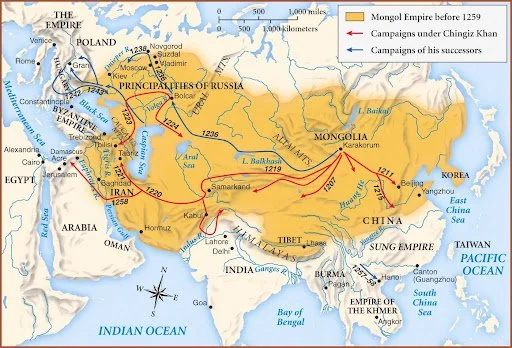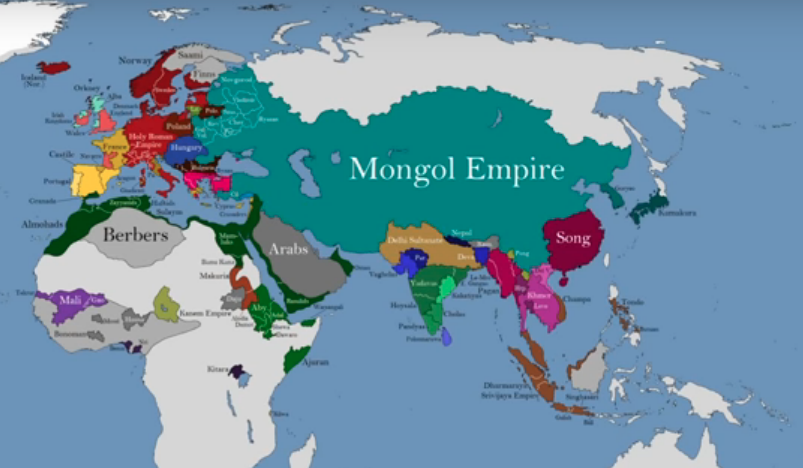Task 3.Mongol guide to world domination
Over a period of 70 years, the Mongols created an empire five times the size of the Roman empire.
But how did they do it?
We are going to create a 5 part guide for empire builders, based on the strategies of the Mongols. You will need to describe how the Mongols used each strategy to build their empire.
Include the following information in your world domination guide.
Describe each of the five steps (see below) to world domination in detail.
Use quotes to illustrate each step
Tips for a successful guide to world domination.
Use examples of each step
Use maps to describe the expansion of the Mongol empire
Include pictures to make your guide more engaging.
Step 1. Unite the Mongol tribes.
Before Genghis, the nomadic Mongols were divided into many warring tribes. Genghis Khan united the Mongol tribes into a single group, in 1206 - the year of the Leopard - he was elected as the Khan or universal ruler. In the Secret History of the Mongols (1228) his shaman (priest) describes what life was like:
'Before you were born [1162] . . . everyone was feuding. Rather than sleep they robbed each other of their possessions. . . The whole nation was in rebellion. Rather than rest they fought each other. In such a world one did not live as one wished, but rather in constant conflict. There was no respite [letup], only battle. There was no affection, only mutual slaughter
(Secret History of the Mongols, sec. 254)
Genghis united the tribes using the following methods.
Tie of marriage (quda). Mongol tribes were tied by intermarriage, daughters were married off to other tribes to form family bonds. The Great Khan even married his own daughters to previous enemies.
Tie of brotherhood (anda). The great Khan exchanged valuable gifts with other warriors. These ties were considered stronger than family ties.
Tie of friendship (nokor). Men would swear loyalty to their leader and promise to follow him everywhere.
Tie of plunder. As the Mongols began to conquer new territories they had new wealth to share with their supporters.
Step 1 to do: Explain the methods that Genghis used to unite the Mongol tribes.
Step 2. Organise an unbeatable army
Mr Khan organised an army with advantages.
All males 15-70 served in the army, all as cavalry. The army’s 95 units of 10,000 soldiers were subdivided into units of 1,000, 100, and 10.
Every soldier was a member of an Arban, these groups consisted of 10 men who did everything together. The men were intensely loyal to one another and their Arban.
Fast horses that could travel large distances in a short time. Each soldier had five horses to ride.
Sturdy soldiers who could live in the saddle for days.
Bows to shoot arrows direct from the saddle
Shields and armour that were made of leather, making them light and easy to travel large distances.
Absolute obedience to orders from superiors was enforced.
No one in the army was paid, though all shared to varying degrees in the booty
Step 2 to do: Genghis Khan created a formidable army with the united tribes. How did he organise them into an unbeatable force?
“Not even a mighty warrior can break a frail arrow when it is multiplied and supported by its fellows. As long as your brothers support one another , your enemies can never gain the victory over you ”
Step 3. Conquer everybody with your fast moving armies, intelligence gathering and new siege warfare methods.
The well organised Mongol army expanded rapidly. As well as being fast and ferocious, Mr Khan was an innovative leader who learned new techniques from the people he conquered to ensure victory.
Gathering intelligence had high priority. Scouts were sent out, local knowledge sought, and traveling merchants rewarded for information. The rapidly developing communication networks of the Mongols made the use of this information invaluable.
Mr Khan understood that the Mongols were very good at warfare on horseback. His genius was to realise that foreign experts and advisors could be used for areas of war that they had limited experience. Notably Chinese and Persian engineers skilled at making and using siege weapons such as catapults and battering rams.
Step 3 to do:
Use maps to show how fast the army moved to conquer neighboring kingdoms.
How could extensive intelligence gathering aid the Mongol war plans?
Why would siege warfare be important for a rapidly expanding empire like the Mongols.
Extra source: Mongol siege of Baghdad C1300
The siege of Baghdad took place in early 1258, the historic capital of the Abbasid Caliphate. A large army under Hulegu, a prince of the Mongol Empire, attacked the city. Within a few weeks, Baghdad fell and was sacked by the Mongol army.
Source questions
What does the source show about how the Mongols practiced siege warfare?
Is the source primary or secondary?
Step 4. Manage the rapid expansion of your empire
In 1206 Mr Khan began a remarkable expansion. At its peak 100 years later, the Mongol empire stretched from the Pacific Ocean to Eastern Europe, an area of 30 000 000 sq / km. In military communications, the Mongols used well-coordinated and efficient transport and signaling that gave them an edge. They signaled by shooting whistling arrows tuned to make different sounds, waving flags (a forerunner of the semaphore), burning torches, and dispatching fast- riding couriers. The army set up and maintained networks of staging posts where riders could rest and exchange horses
Step 4 to do:
Use examples to explain how the Mongols managed their rapidly expanding empire?
What were the benefits of successfully managing the empire and making it safe? (Hint. trade can be taxed)
“Conquering the world on horseback is easy; it is dismounting and governing that is hard. ”
Step 5. Make your empire safe and collect the spoils
The Mongols had control of the vast trade networks between Asia, the Middle East and Europe. (Remember the Silk Rd?)
Step 1 to do do:
Use a map to explain the extent of Mongol trade networks
How did the Mongols manage these extensive trade networks and keep them safe?
What was the benefit of making the trade networks safe?
Extra source: The new Silk Road. History on the net
To facilitate trade, Genghis offered protection for merchants who began to come from east and west. He also offered a higher status for merchants than that allowed by the Chinese or Persians who despised trade and traders. During the period of the Mongol Empire, merchants found protection, status, tax exemption, loans and consistent aid from the Khans. For the 100 years of the height of the Empire, the East-West Mongol trade routes became the fabled Silk Road which for the first time linked Europe to Asia, allowing the free flow of ideas, technologies and goods.
Source questions
Who produced this source?
Is the source primary or secondary?
What does the source show about how the Mongol's supported trade networks.
“Under the reign of Chinggis Khan, all the countries . . . enjoyed such peace that a man might have journeyed from the land of the sunrise to the land of sunset with a golden platter upon his head without suffering the least violence from anyone. ”
Epilogue: Mongols. The good and the bad.
The Mongols have a fearsome reputation for carnage and chaos, but there were benefits to their reign.
The migration and trade that was possible under the Mongol system meant that there was frequent and widespread contact between peoples of widely different cultural, ethnic, religious, and language backgrounds. This resulted in the exchange of goods, ideas and new technologies.
Thousands of people travelled from western and central parts of Eurasia to serve the Mongol regime in China. Marco Polo, the Venetian merchant who travelled to China with his father and uncle in 1271 and remained there for seventeen years, was just one of these foreigners seeking opportunity in Mongol administration.
Epilogue to do:
Describe the pros and cons of the Mongol expansion.




